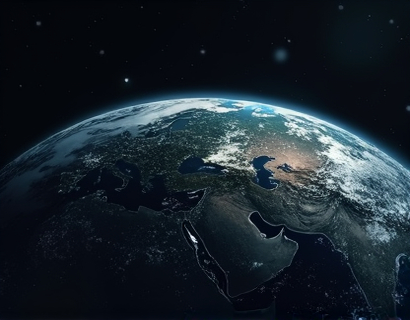Unlocking the Cosmic Formula: Discovering the Hidden Intersection of Science and Mathematics
The universe, in its vast and intricate beauty, holds secrets that have captivated human minds for centuries. At the heart of understanding these secrets lies the profound intersection of two of humanity's most powerful tools: science and mathematics. This article delves into the hidden connections between these two disciplines, exploring how complex theories and real-world phenomena converge to reveal hidden patterns, igniting curiosity and deepening our understanding of the cosmos.
Science and mathematics are not merely separate fields of study; they are intertwined in a dance of discovery that has propelled human knowledge forward. Mathematics, often described as the language of the universe, provides the precise tools necessary to describe and predict the workings of the natural world. Science, on the other hand, employs these mathematical tools to explore, experiment, and explain the phenomena observed in nature.
The Mathematical Universe
The idea that the universe is fundamentally mathematical is a notion that has been championed by many prominent scientists and philosophers. Einstein, for instance, famously stated, "As far as the laws of mathematics refer to reality, they are not certain; and as far as they are certain, they do not refer to reality." This paradox highlights the deep connection between mathematics and the physical universe. The laws of physics, from the simplest to the most complex, are expressed in mathematical terms. The equations of Newtonian mechanics, the wave equations of electromagnetism, and the equations of general relativity are all mathematical descriptions of natural laws.
The beauty of this mathematical universe lies in its consistency and predictability. Mathematical models allow scientists to make precise predictions about natural phenomena, from the orbits of planets to the behavior of subatomic particles. These predictions are then tested through experiments and observations, further validating the mathematical framework that describes our universe. This cycle of theory, prediction, and experimentation is the cornerstone of the scientific method, and mathematics is its indispensable language.
Hidden Patterns in Nature
One of the most fascinating aspects of the intersection between science and mathematics is the discovery of hidden patterns in nature. These patterns, often mathematical in nature, reveal the underlying order of the universe. For example, the Fibonacci sequence, a simple mathematical series where each number is the sum of the two preceding ones, appears in the arrangement of leaves on a stem, the branching of trees, the spirals of shells, and the structure of galaxies. This sequence, while seemingly abstract, is a manifestation of the mathematical principles that govern growth and form in the natural world.
Fractals, another mathematical concept, are found throughout nature, from the intricate patterns of snowflakes to the rugged coastlines of continents. Fractals are self-similar structures that repeat at different scales, and they provide a powerful tool for understanding complex systems. The Mandelbrot set, a famous fractal, is a prime example of how simple mathematical rules can generate infinitely complex and beautiful patterns. These patterns not only enhance our appreciation of the natural world but also provide insights into the fundamental principles that govern it.
Quantum Mechanics and Mathematical Beauty
The realm of quantum mechanics is perhaps the most striking example of the deep connection between science and mathematics. Quantum mechanics is a branch of physics that deals with the behavior of particles at the smallest scales, where classical physics breaks down. The mathematical framework of quantum mechanics, based on wave functions, operators, and probability amplitudes, is both elegant and counterintuitive. The Schrödinger equation, a central equation in quantum mechanics, is a partial differential equation that describes how the quantum state of a physical system changes over time.
The mathematical beauty of quantum mechanics is evident in its ability to predict phenomena that have no classical counterpart. For instance, the concept of superposition, where particles can exist in multiple states simultaneously, and entanglement, where particles become interconnected regardless of the distance separating them, are both mathematically precise and profoundly mysterious. These phenomena challenge our intuitive understanding of reality and highlight the power of mathematics in describing the quantum world.
Mathematics in Cosmology
Cosmology, the study of the origin, evolution, and fate of the universe, is another field where the intersection of science and mathematics is particularly evident. The Big Bang theory, the leading model for the origin of the universe, is based on a set of mathematical equations that describe the expansion of the universe. The Friedmann equations, derived from Einstein's general relativity, govern the dynamics of the cosmic expansion and are essential for understanding the large-scale structure of the universe.
The cosmic microwave background (CMB), the afterglow of the Big Bang, provides a wealth of data that cosmologists use to test and refine their mathematical models. The tiny temperature fluctuations in the CMB, measured with high precision by satellites like COBE, WMAP, and Planck, are analyzed using statistical methods to extract information about the early universe. These analyses have led to the determination of key cosmological parameters, such as the age of the universe, the density of matter, and the nature of dark energy.
Mathematics and the Search for Extraterrestrial Intelligence
The search for extraterrestrial intelligence (SETI) is another area where mathematics plays a crucial role. The vastness of the universe and the potential for intelligent life elsewhere raise fundamental questions that can be addressed through mathematical reasoning. The Drake Equation, a probabilistic argument used to estimate the number of active, communicative extraterrestrial civilizations in the Milky Way galaxy, is a prime example. This equation combines factors such as the rate of star formation, the fraction of stars with planetary systems, and the probability of the emergence of intelligent life.
The mathematical approach to SETI not only provides a framework for thinking about the likelihood of intelligent life but also guides the design of experiments and the interpretation of data. Radio telescopes, for instance, scan the sky for signals that match the patterns predicted by mathematical models of extraterrestrial communication. While no definitive signal has been found yet, the ongoing search continues to push the boundaries of both mathematics and our understanding of the universe.
Mathematics in Biology and Evolution
The intersection of mathematics and science extends beyond physics and cosmology to biology and evolution. Mathematical models are essential for understanding the complex dynamics of biological systems, from the behavior of individual cells to the evolution of species. Population dynamics, for example, use differential equations to model the growth and interaction of populations, taking into account factors such as birth rates, death rates, and environmental constraints.
Evolutionary biology also relies heavily on mathematical tools. The theory of natural selection, proposed by Charles Darwin, can be formalized mathematically to predict the changes in allele frequencies in a population over time. The Hardy-Weinberg equilibrium, a principle in population genetics, uses mathematical equations to describe the genetic structure of a population in the absence of evolutionary forces. These mathematical models help biologists understand the mechanisms of evolution and make predictions about the genetic diversity of populations.
Conclusion
The exploration of the hidden intersection between science and mathematics reveals a universe that is both beautiful and intelligible. The mathematical framework provides the language and tools necessary to describe, predict, and understand the natural world. From the smallest subatomic particles to the vast expanse of the cosmos, the interplay between science and mathematics continues to uncover the profound secrets of the universe. As we deepen our understanding of these connections, we not only expand our knowledge but also ignite our curiosity and inspire new generations of scientists and mathematicians to continue the quest for knowledge.










































